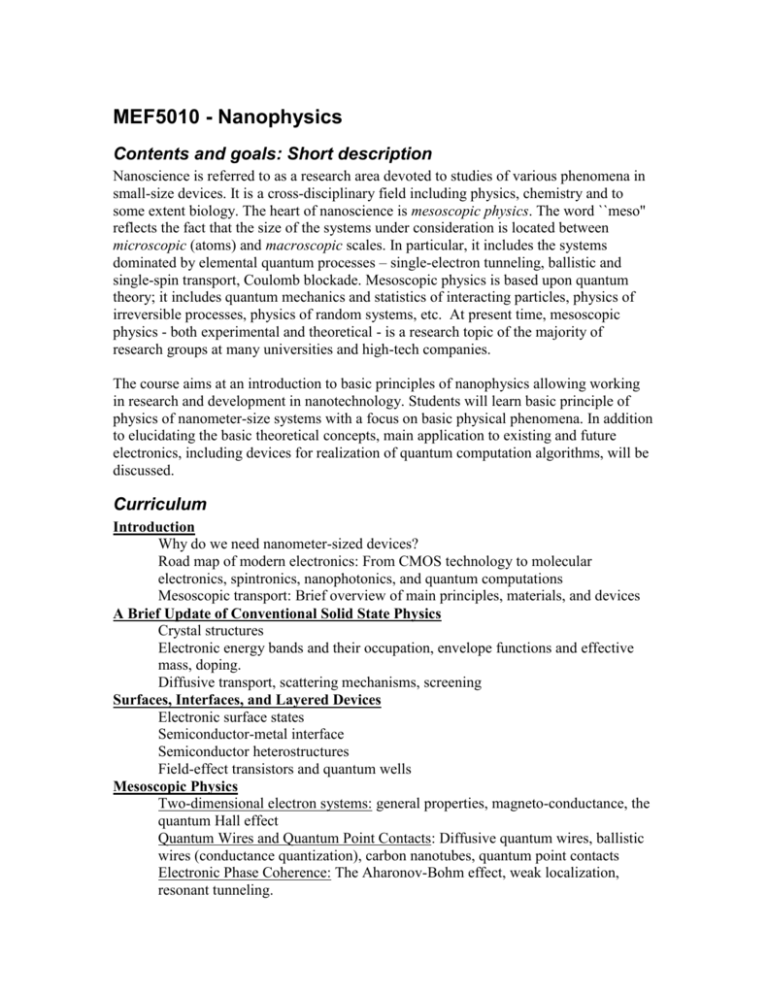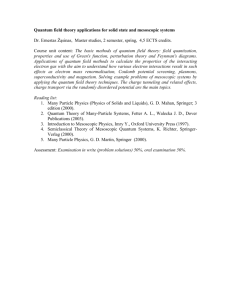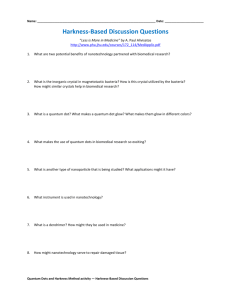MEF5010 - Nanophysics
advertisement

MEF5010 - Nanophysics Contents and goals: Short description Nanoscience is referred to as a research area devoted to studies of various phenomena in small-size devices. It is a cross-disciplinary field including physics, chemistry and to some extent biology. The heart of nanoscience is mesoscopic physics. The word ``meso'' reflects the fact that the size of the systems under consideration is located between microscopic (atoms) and macroscopic scales. In particular, it includes the systems dominated by elemental quantum processes – single-electron tunneling, ballistic and single-spin transport, Coulomb blockade. Mesoscopic physics is based upon quantum theory; it includes quantum mechanics and statistics of interacting particles, physics of irreversible processes, physics of random systems, etc. At present time, mesoscopic physics - both experimental and theoretical - is a research topic of the majority of research groups at many universities and high-tech companies. The course aims at an introduction to basic principles of nanophysics allowing working in research and development in nanotechnology. Students will learn basic principle of physics of nanometer-size systems with a focus on basic physical phenomena. In addition to elucidating the basic theoretical concepts, main application to existing and future electronics, including devices for realization of quantum computation algorithms, will be discussed. Curriculum Introduction Why do we need nanometer-sized devices? Road map of modern electronics: From CMOS technology to molecular electronics, spintronics, nanophotonics, and quantum computations Mesoscopic transport: Brief overview of main principles, materials, and devices A Brief Update of Conventional Solid State Physics Crystal structures Electronic energy bands and their occupation, envelope functions and effective mass, doping. Diffusive transport, scattering mechanisms, screening Surfaces, Interfaces, and Layered Devices Electronic surface states Semiconductor-metal interface Semiconductor heterostructures Field-effect transistors and quantum wells Mesoscopic Physics Two-dimensional electron systems: general properties, magneto-conductance, the quantum Hall effect Quantum Wires and Quantum Point Contacts: Diffusive quantum wires, ballistic wires (conductance quantization), carbon nanotubes, quantum point contacts Electronic Phase Coherence: The Aharonov-Bohm effect, weak localization, resonant tunneling. Single-Electron Tunneling: Coulomb blockade, single-electron tunneling devices, electron pumping, etc. Quantum Dots: Role of electron-electron interaction, conductance resonances, etc. Mesoscopic superconductivity: Josephson effect and its applications, hybrid systems, etc. New Directions in Electronics Spintronics, Molecular Electronics, Nanomechanics, Nanophotonics, Devices for Quantum Computation Experimental Aspects (will be presented by students and taken into account for the exam grade) Sample growth and fabrication: Single crystal growth; growth of layered structures, epitaxy - liquid phase epitaxy (LPE), molecular chemical vapor deposition (MOCVD), molecular beam epitaxy (MBE), magnetron sputtering, etc. Lateral patterning (electron beam patterning) and bonding. Sample characterization: Electron microscopy (TEM, SEM); Tunneling microscopy (STM); Secondary ion mass spectroscopy (SIMS); X-ray spectroscopy; Elements of cryogenics. Format of the course The best format for would be the framework of the intensive course when the lectures are delivered during a short period. That would make it possible for the students oriented to nanoscience and nanotechnology combining this course with the courses on Nanochemistry and Nanotechnology presented by Professors II. My suggestion is to arrange the lectures as 2-week seminar-like program plus compulsory students’ presentations.







